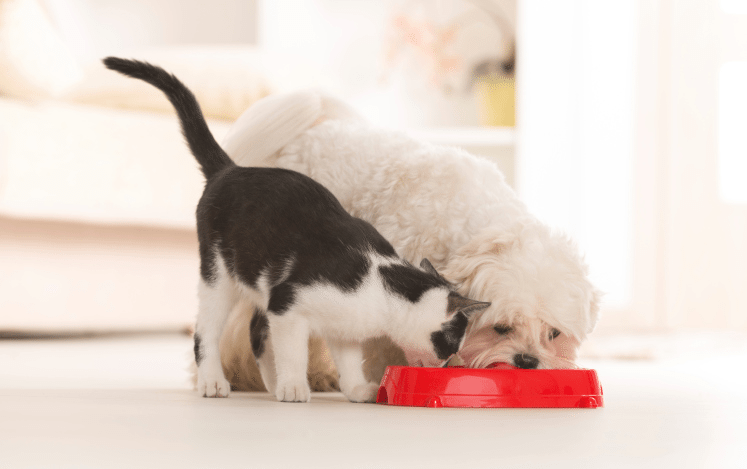The FDA released a press release on July 2nd about the dangers of the feeding your pet a raw diet. They warn that it can pose health risks to both you and your pet. William J. Burkholder of the FDA explained, “Feeding raw foods to pets increases the risk that both the pet and the people around the pet will encounter bacteria that cause foodborne illness, particularly if the products are not carefully handled and fed.”
Raw diets certainly get a ton of discussion in the pet community. Many pet professionals and parents are passionate that raw diets are better for dogs and cats than commercial pet foods. We wanted to get a perspective from a raw diet proponent, so Wagbrag spoke with Jerry Cardozo, owner of a holistic nutritional store for dogs and cats located in Roswell, Georgia.
Question:
Lately I have heard a lot about raw diets. Is this worth considering for my pet?
Answer:
Jerry believes that most pets should be on at least a partial raw diet, and many proponents would agree with his reasoning. Dogs and cats are, first and foremost, carnivores. As such, there should be meats in their diets as this is how their systems are designed. Jerry, and other advocates of raw diets, would argue that many commercial foods do not, on their own, provide for this need adequately.
Benefits of a raw diet can include:
Better hydration
A raw diet is 70-80% moisture, whereas dry food is only about 10% moisture. This is important, especially for cats, who often do not drink enough water to meet their hydration needs. Plus, dry foods are often loaded with sodium, further contributing to dehydration, which can ultimately lead to urinary tract infections and even kidney stones.
More essential nutrients
Raw foods can provide crucial organ meats and ground-up bone that dogs and cats need. The bone provides the needed calcium and phosphorus, and also regenerates the animal’s own bone growth. In dry foods, the bone may be so finely crushed into a powder that it is too weak to make much difference. Dry foods are designed to last up to 2-3 years on a shelf, so much of the meat oils and juices must be extracted to lengthen shelf life.
Potentially a stronger immune system
Some proponents argue that a raw or partial raw diet may strengthen an animal’s immune system. Because it is more natural and less processed, raw foods contain less preservatives and fillers that may potentially compromise an immune system. Raw foods travel through the animal’s intestines within 12 or fewer hours. By contrast, dry foods may take 24-48 hours to pass, even with the best quality foods.
What To Consider Before Switching Your Pet To A Raw Diet
In many cases, it may not be practical to immediately switch to a 100% raw diet. There are several considerations to keep in mind if you would like to try a raw diet. Initially, it may make sense to only try a partial raw diet, supplementing the animal’s existing food, as your pet can still get many of the benefits this way. Cats, in particular, often become accustomed to their existing canned or dry foods, and may not want to make the switch. Canned foods have flavoring and sodium that make them taste good, and raw foods may seem bland in comparison.
Some precautions must be taken when moving to a raw diet, especially from a safety standpoint. You will need to monitor your pet when they eat – you cannot just throw down raw food and leave. If the animal does not eat all of their food within a half hour or so, you will need to throw the remains away. You will also have to take more precautions when handling the raw food, to avoid any potential for food-borne illnesses. If the animal is ill in any way, especially with an immune-compromised condition such as cancer, raw diet becomes more of a coin toss. Jerry has seen instances when chronically sick animals have done extremely well with raw foods, but there is also a chance they could be negatively affected, due to the bacteria present in raw foods.
From a practical standpoint, raw food may cost more than a traditional diet. You may save money if you buy in bulk or a case at a time, but you will have to cut it up and portion it out yourself and then refreeze it. You will also need to make sure you have enough freezer space to hold your pets’ food.
Some veterinarians are skeptical of a raw food diet. They may think it is unnecessary to move pets to a raw food diet, as they believe that there are many high quality commercial pet foods available. Along those lines, some vets believe that many pet owners are not able to handle the additional workload and preparation that a raw food will require. Finally, concerns exist about the safety of feeding animals a raw food diet.
If you are considering moving your pet to a raw (or partial raw) diet, set aside some time to do very in-depth research. You will find different opinions out there, so it’s important to talk to a variety of professionals to ensure you get enough information to make your own informed decision. If you do decide to try raw, make sure you contact a pet nutrition store, preferably one with a holistic slant, to get accurate advice about the proper introduction and handling of a raw diet.
Photo 1: Thinkstock
Photo 2: Courtesy of eviltomthai via Flickr (CC by 2.0)










